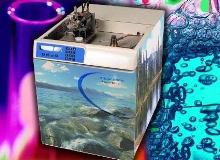Flame Ionization Detector Interface uses superheated water.
Press Release Summary:
 Aquachrom Interface is comprised of small metal beads sintered inside stainless steel tubing that is placed directly into FID. Restrictor delivers water in form of fine mist so that flame maintains stability. Suited for temperature programmed liquid chromatography (TPLC), interface can be attached directly onto outlet of column, or flow can be split for conventional columns. Aquachrom is capable of isothermal and temperature programming using 1.0, 2.1, or 4.6 mm columns.
Aquachrom Interface is comprised of small metal beads sintered inside stainless steel tubing that is placed directly into FID. Restrictor delivers water in form of fine mist so that flame maintains stability. Suited for temperature programmed liquid chromatography (TPLC), interface can be attached directly onto outlet of column, or flow can be split for conventional columns. Aquachrom is capable of isothermal and temperature programming using 1.0, 2.1, or 4.6 mm columns.Original Press Release:
Selerity Technologies Introduces New Flame Ionization Detector Interface to Make Use of Superheated Water Even More Efficient
SALT LAKE CITY, Utah (May 17, 2005) - Temperature Programmed Liquid Chromatography (TPLC) specialist, Selerity Technologies Inc has developed a new interface for its Aquachrom "green machine", the first instrument to use superheated water as the mobile phase for HPLC separations. The new interface has been designed to take advantage of the full benefits of the Flame Ionization Detector (FID) by controlling the water eluent as it enters the detector.
The new interface ensures that a blast or stream of water does not extinguish the flame during a run. Comprising small metal beads sintered inside a stainless steel tubing placed directly into the FID, the restrictor delivers the water in the form of a fine mist so that the flame maintains stability. This interface can be attached directly onto the outlet of the column to achieve high sensitivity with small diameter columns, or the flow can be split for use with more conventional columns.
The Aquachrom directly applies the principles of gas chromatography theory to the requirements of liquid chromatography technology, providing the added benefits of decreased elution times, increased efficiencies and universal detection. By using superheated water instead of organic solvents as the mobile phase for chromatographic runs, Selerity's FID oven is the perfect solution for laboratories looking for more environmentally-friendly instrumentation and green chemistry techniques.
The Aquachrom is capable of isothermal and temperature programming operation with the option of using 1.0, 2.1 or 4.6 mm columns. The amount of the superheated water flowing into the detector, the position of the restrictor within the flame jet, the mixture of detector gases and the temperature of the detector are all essential parameters to the function of this technique. They can be easily adjusted to obtain the sensitivity that is commonly obtained by gas chromatography using a FID.
For more information about the Aquachrom and TPLC method development, please visit www.selerity.com or e-mail sales@selerity.com




